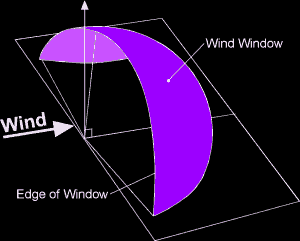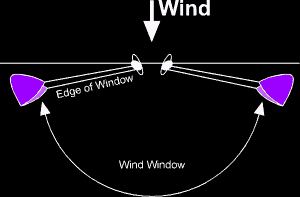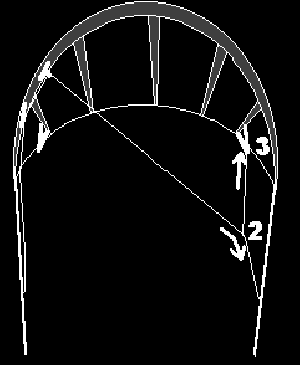  
|
||
|
The Wipika Wing concept protected by international patent. It is sold for a private use only. Any kind of commercial
use - including as an advertising display, image appropriation, etc...
- without the express written consentment of the patent holders is prohibited
by law. PRESENTATION Congratulations you have just purchased a Wipika Wing. You chose simplicity and all-round performance. Wipika is the only hassle free kite capable of pulling you safely around on any gliding surface, including water for which it has been specifically designed. But behind apparent simplicity is a very technical performce design, which needs some knowledge and caution. We recommend to carefully read these guidelines.List : 1 - Body 2 - Inflatable leading edge 3 - 5 inflatable cross battens 4 - Flying lines 5 - Internal bridle General principle · 2 control lines, left & right, to steer the wing into the wind. Aerodynamics work in a similar way toregular sails, hence similar upwind capability, eventually limited by the towed craft own's upwind capability. 1 REPAIR WORK The inflatable battens are made of sailcloth and inner tubes. Tubes can be replaced. If punctured, find the leak by pushing the inflated batten under water. · When found, deflate then partially remove the tube (by either the trailing edge opening or the valve hole or the front zipper). Inflate the inner tube, mark the leak then clean all around it. Apply a piece of adhesive fabric or a drop of soft PVC contact glue such as CLEAR PATTEX. Let it dry then put it back in place. In case of major hole, try to glue a piece of soft PVC or change the whole tube. APPLICATIONS Parakart / Buggy and Beach roller skates on grass and hard sand. Skates on hard surfaces (concrete, ice, salt). Flysurfing, body dragging, sea kayacking, sailboat or other water crafts. Ski or snowboard. Each application requires different gear. BRIDLE The internal bridle consists of 2 main Dyneema lines (high module P.E.) and of secondary lines which get under tension when you pull one of the flying lines. The wing is properly tuned when the internal bridle is under slight tension in flight, which means you only need to pull a few cm/inches of the main lines for the wing to react. If the wing steers poorly, it's probably either because the internal bridle is not properly tensioned, or because the tubes are not inflated enough. If the lines get tangled, you can easily disconnect them in different places, because all attachments feature a slipknot and a stop knot. Try to understand and memorize the internal bridle. STORAGE Pinch the valves to start deflation. · Fold the wing and put it in its bag. Carefully rewind the lines and put the winder on a side of the bag. For those owning a Wipika boom, the winder is already on it. LEARNING PROCESS You should to learn
how to fly and steer the wing on land before using it for traction
and going out to sea. TAKE-OFF ON LAND If you have an assistant, ask him to hold the wing to the middle of the leading edge at 100° to the wind. If you are by yourself, fold one of the tips of the wing up to the first cross batten, then cover it with enough sand for the wing to stand still. In both cases, move to tension the lines, wing on the side of the window of flight, almost cross-wind. Check for loops or tangle in lines and bridle. Move back to tension the lines. The wing gently
takes flight. Learn to stabilize it a few feet off the ground, to
rise and descend on the other side without landing. SAFETY You must be able to depower instantly in case of a strong gust, obstacle or loss of control. You also must be able to set the wing free, notably if a boat was to catch the lines. Therefor a safety quick release system must be used. Examples : - Libra safety systems in kiteshops, - Wichard quick releases + bodyboard leash in surf & sail shops - Wipika boom · Never under-estimate the wing's potential power. Always have clear space downwind of you. · Do not fly over people or animals. Flying lines under tension are sharp. · At sea, wear life vest, wetsuit and gloves. · On land, wear helmet, glasses, strong clothes, gloves and appropriate shoes. Do not fly if you can't hold on to the wing in a stand still position. Check for local rules and regulations. Don't fly near power-lines or airports. · At sea, wear a surf leash for board use. The Wipika wing has not been designed for flying applications. It is extremely dangerous to attempt jumping or gliding over the land. It may result into serious injury for which we cannot be held responsable. . |
|

CONTROL SYSTEMS Your Wipika wing is rigged with a 2 line system and works as a regular kite. It goes left if you pull left & right if you pull right. On the other hand it requires less pull to steer compared to other similar size kites. Wipika takes any 2 lines control system, from simple handles to pulley/harness combination to control bar. In all cases,always
carry a reliable quick release system to garantee safety PREPARATION Back to the wind, take the wing off the bag and place its leading edge towards you and battens facing sky. Block it on the ground with sand . Clear the bridle, connect the flying lines to the bridle by sticking the stop knot into the slipknot. Unwind and clear the flying lines Attach them to the control system. Inflate the 5 cross battens first, then the leading edge. Important : - The Wing's inner tubes must have enough to keep its shape, but do not over-inflate by forcing the pump. - Do not sink the valves into the tubes. Clear the bag, winder and pump away. Put the harness on or attach the control system to your craft. Caution : · Neither the pump or the inner tubes and valves like sand and salt water : avoid contact and clean the pump before. Watch out for thorns or sharp edges when laying down the wing for inflation. Do not let the wing flutter in the wind for long. Oil pump once in
a while with 1 or 2 drops on the back valve and then by "sucking
it up" Watch out for thorns or sharp edges when laying down the wing for inflation. Do not let the wing flutter in the wind for long. Lubricate the pump once in a while by placing 1 or 2 drops of oil on the back valve and then by "sucking it up" WATERSTART Learn how to crash and waterstart the wing in shallow water. Do so untill you master this maneuver. If the wing lays flat, right way up or upside down, just let the wind tension the lines and unfold the wing. Then slowly pulling a couple feet left or right, let the wing arrive at a half-moon vertical position. It goes upwind up to the side of window of flight and, at this point, takes off when pulling the top line. Certain skills are necessary to pilot the kite. Caution : · Side-shore moderate winds are best to learn. · Do not fly in dead off-shore conditions. LANDING If there is someone available, lower the wing to ground level on the side of window and ask him to catch it by the leading edge only. Do not let anyone near the trailing edge or flying lines. It can be dangerous. Then release lines tension by getting to the wing and block or deflate it. Without an assistant, place the wing above you then drop a line. The wing luffs and falls down. Choose a clear landing spot with enough room to keep lines away from anything. Caution : When you drop one line, do not let it take the bar or handle with it, which could be harmful to someone. Get to the wing, keeping the line tightened then block or deflate. To block the wing on ground without excessive fluttering or chance to fly away, put it upside down, leading edge upwind and cross batten facing ground. Put sand along leading
edge. In this position your wing can bear pretty strong winds.
Rince your wing
with fresh water and let it dry in the shade away from the wind.
|

